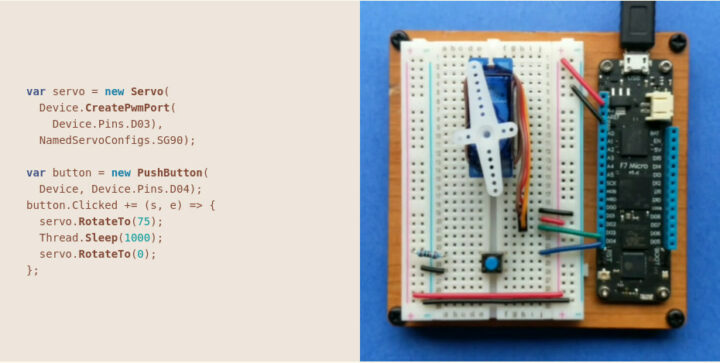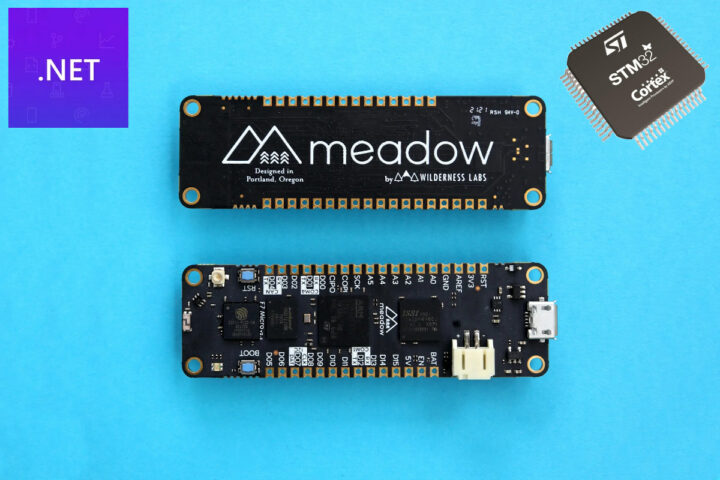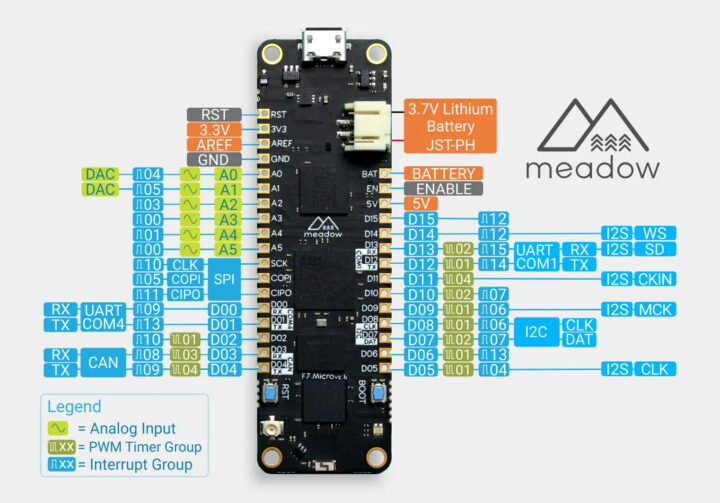Wilderness Labs Meadow F7v2 Feather is an STM32F7 Arm Cortex-M7 development board following the Adafruit Feather form factor and programmable with C# through a lightweight implementation of the .NET framework.
We had previously seen the .NET Framework running on Android and Linux thanks to Xamarin’s Mono, but I don’t think I had ever a microcontroller-class board supporting the .NET framework and C# programming. But that’s exactly what the Meadow F7v2 Feather does.
Meadow F7v2 Feather specifications:
- MCU – STMicro STM32F7 Arm Cortex-M7 microcontroller @ 216 MHz with 2D graphics and JPEG accelerators
- Memory – 32MB RAM
- Storage – 64MB flash
- Connectivity – 2.4 GHz WiFi and BLE (ESP32) with onboard and external u.FL antennas
- USB – 1x Micro USB port for power and programming
- Expansion with through and castellated holes with up to 25x GPIO, 12x PWM, 6x analog inputs, 2x DAC, I2C, I2S input/output, SPI, UART, CAN Bus
- Misc – RGB LED, DFU Boot button
- Power Supply
- 5V via micro USB port
- 2-pin JST connector for 3.7V LiPo/Li-Ion battery; integrated charging circuit
- Dimensions – Adafruit Feather form factor
As its name implies the F7v2 is an upgrade from the Meadow F7 Feather (launched on Kickstarter a few months ago) with a higher capacity flash (64MB vs 32MB), an upgraded antenna delivering “10x better performance”, I2S audio support, higher quality buttons, and a new silkscreen design that makes bus IO identification much easier.
The board is running a micro Real-Time OS (µRTOS) and a .NET Standard compatible runtime with “full-stack” IoT APIs for connectivity, power, sleep, etc… You’ll find how to get started and code samples using the Visual Studio IDE on the developer’s website.

The company says Meadow is a “complete, IoT platform with defense-grade security that runs full .NET Standard applications on embeddable microcontrollers” and provides Meadow.Cloud to manage devices remotely, but I suppose it’s mostly interesting to engineers and/or companies with C# expertise who wants to develop embedded systems with a lower learning curve/ faster time to market.
Meadow F7v2 Feather is sold for $45 on the company’s store, where you’ll also find a system-on-module with similar specs and the same price, as well as development kits with more expansion capabilities through Mikobus headers. If you prefer to have .NET support on your own embedded hardware, Wilderness Labs can license Meadow for $5 and up per device.
Thanks to Frank for the tip.

Jean-Luc started CNX Software in 2010 as a part-time endeavor, before quitting his job as a software engineering manager, and starting to write daily news, and reviews full time later in 2011.
Support CNX Software! Donate via cryptocurrencies, become a Patron on Patreon, or purchase goods on Amazon or Aliexpress





